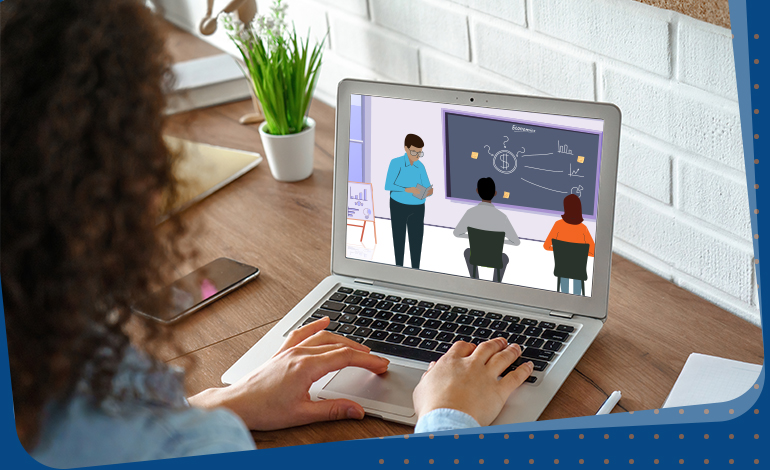Simulation-based learning has been around for such a long time now that it has become commonplace. Several industries are using it:
- Aviation – Pilots in training use flight simulators to get familiar with plane controls and practice flying in different weather and landing conditions.
- Math – Mathematicians and economists are using simulations to study probabilities and statistics in a theoretical event.
- Manufacturing – Such plants now have simulation tools to plan, design, and train automated processes and manufacturing systems.
- Medical – Med students are using simulations to practice surgeries, crisis interventions, and administer prescriptions.
In the eLearning industry, the pandemic only accelerated simulation-based learning. Here are some real-life examples that can help you understand.
1. Recently, the University of South Australia conducted several simulated activities in-person when the campuses reopened. Several simulated scenarios (computed tomography sim, vacbag manufacture, tattooing, personal protective equipment, etc.) enabled the university to achieve all clinical placement learning outcomes.
2. Glendale Community College in California has developed a tax simulation game for a microeconomics principles course. It teaches students to explain the link between a tax system and income distribution, identify the distributional effects of different taxes, and justify the chosen tax incidence. Students can set federal, state, and local taxes.
3. BBC developed an interesting simulation on the refugee experience mirroring the Syrian refugee crisis triggered in 2015 to help students understand the experience of the refugees and the dilemmas they faced while fleeing to Europe.
What is simulated learning anyways?
Let’s get deep into what is a simulated learning experience. You can think of simulation as a novel teaching method that tests your knowledge and skill levels by placing you in immersive problem-solving scenarios. In a simulation, usually, the instructor defines the parameters, with the end-goal being to create a safe environment for hands-on learning experiences.
Simulated training is being used in several industries to teach learners the skills needed in the real world, as we saw from the examples above. A simulation is considered effective if it answers your question, “If I do this, what happens?”
In a simulation you can test out different scenarios to see what works through a trial-and-error approach, giving you the knowledge and confidence to apply your new skills in the real world. And today, with the help of video recordings and advanced analytics, the instructor can analyze training sessions, identify errors, and discuss alternative approaches with learners.
Why simulated learning works?
Three solid reasons why it works.
1. Practical learning: How many times have you all heard this in school – “Practical is always better than theory.” And there is merit to that. Simulations can give you practical experience in the real world and prepare you well. As a med student, you can learn to perform operations and understand human anatomy better through 3-D simulations. Or, if you’re a business school student, you can learn about building better products, market, sell and service them. Bottom line, you can focus on crisis resource management and develop knowledge, skills, and attitudes in a safe and secure environment.
2. Instant feedback and a great retention aid: Learning-based simulations offer real-time and prompt feedback. You can get constructive and instant feedback, which helps you improve your skills. You can also try new, alternative skills or methods to improve old methods and test new tools. Plus, simulations make learning fun for you. Think of how much you retain from watching a fun video on machine learning algorithms rather than reading a long pdf file filled with numbers and graphs. Simulation-based learning programs equip you to better understand the actions you can take in a situation, which validates the results of training and makes it effective.
3. Collaborative skills: Perhaps, another most significant benefit of simulation-based learning is developing your collaborative skills in a fun way. In a simulated environment, you are introduced to several real-life scenarios, which would need you to collaborate with other members of your team. You also get insights into your own behavior.
The future of simulation-based learning
With Virtual Reality simulators becoming more accessible, less expensive, and increasingly realistic, simulation-based learning are the go-to mode for bridging the gap between structured training and real-life experiences.
Today learners are digital technology natives, so their expectation is that training will challenge them, immerse them into a personalized learning journey. Simulation-based learning helps meet that learner expectations by offering VR experiences, 3D-avatar based learning environments or AI-based role-play simulations.
This helps to accelerate the learning curve of learners in a simulated environment, reproducing real-life conditions without time or space limitations and much fewer risks than real environments. It’s also supported by a recent study, supported by the Korea World Bank Partnerships Facility. The study shows that VR training is, on average, more effective than traditional training, developing students’ technical, practical, and socio-emotional skills. And the results are particularly promising in the fields of health and safety, engineering, and technical education.
How can Liqvid help?
Training simulations should not be created in isolation. Businesses need a robust learning management system for delivery and analytics to loop in feedback and continuous improvement of the learner. We have been creating simulations for educational institutions for a few years, and the demand has been increasing since the pandemic hit us.
One of our recent projects was about developing a multi-player, virtual pharmacy simulation game for a polytechnic in Singapore to make their students proficient in routine tasks performed in a pharmacy – receiving, typing, packaging, and dispensing. And the result – improved engagement, better learning, and retention!
Several top vocational training and education institutes are widely using simulations for skill development. Contact us if you need a partner to help make your simulation-based learning needs a reality.

